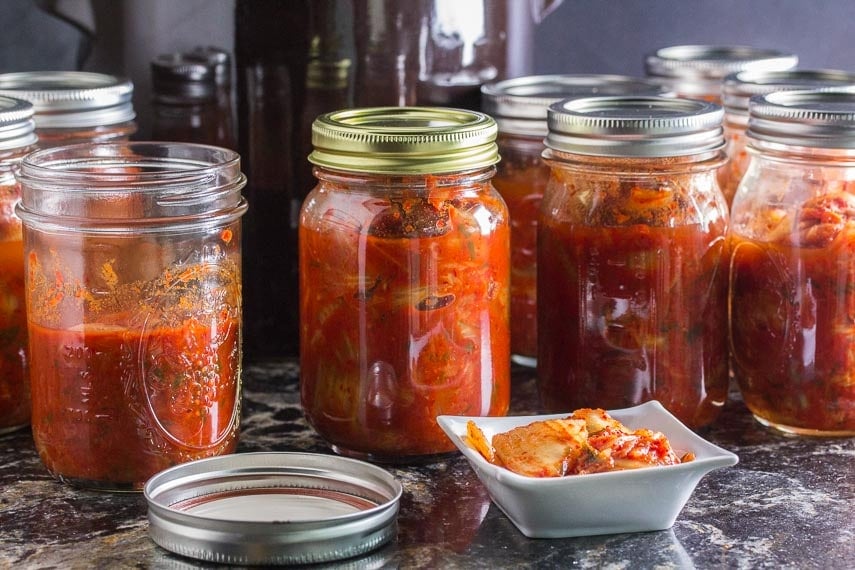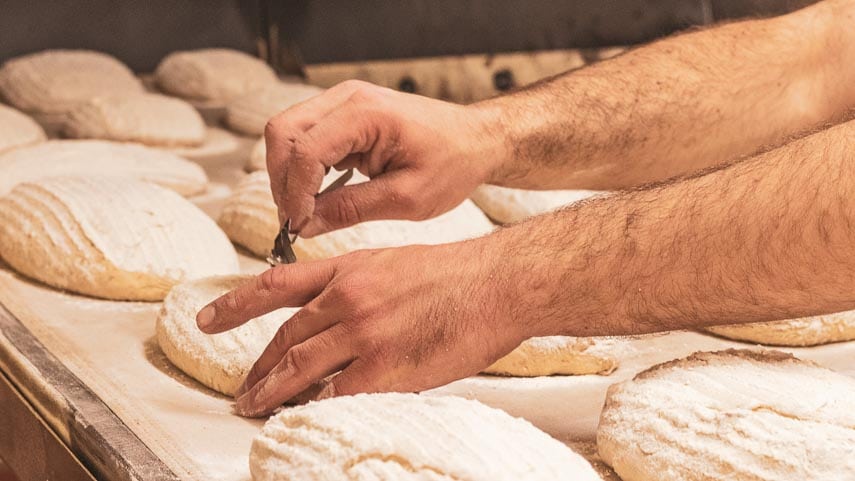Is Kimchi Low FODMAP?
Kimchi is a fermented condiment with a rabid following (us included). Is Kimchi Low FODMAP? The quick answer is probably yes, in some unknown quantity, which will also vary depending on recipe or product purchased. This answer is phrased very specifically and I will explain all in this article.
June 2020 Editor’s Note: In the most recent Monash app update, kimchi was tested and Monash has reported low FODMAP serving sizes of 47 g (which is about ⅓ cup). No information is given on brand or ingredients. We contacted Monash and they confirmed that, “The kimchi samples did contain garlic and onion, and were also unpasteurised.” This is all very interesting and helpful information to keep in mind as you read this article.
Their information and ours will help you make decisions about commercially prepared kimchi that you might buy and its potential FODMAP content. And of course, you can always make our Low FODMAP Kimchi.
Basically if we are talking about a raw, live, unpasteurized kimchi, then every single batch has the potential to be different in terms of FODMAPs – and even the same batch could present different FODMAP levels in lab testing depending on WHEN during the fermentation process the test is carried out.
If the product is pasteurized, there are additional issues to be aware of.
Let’s dive in. Please read this article to the end and I promise, it will all make sense.
First we have to talk about Fermentation, Probiotics & Pasteurization
Fermented Foods
Fermentation is an ancient method of preserving food and is used to make wine, kombucha, yogurt, cheese, sourdough bread and our topic of interest, kimchi.
Fermentation is a natural process that occurs when microorganisms like bacteria and yeast convert carbohydrates, such as starches and sugar, into alcohol and acids.
As you know, FODMAPs are carbohydrates. Hold onto that thought.
When cabbage is used to make kimchi, the natural lactobacilli bacteria present on the surface of the vegetable help break down the sugars in the cabbage during the kimchi making process, which leads to what is called lacto-fermentation.
The rate of fermentation is dependent on temperature, other ingredients used in the recipe, such as salt, and the concentration of those other ingredients. How large or small the cabbage is cut and the exposed surface area are factors as well.
Carbon dioxide is produced during fermentation, which is why you can often see a batch of kimchi or sauerkraut bubbling. It IS alive! It is those live bacteria that are creating the CO2.
Let’s Talk Probiotics
Cultured and fermented foods can contain probiotics. Remember the lactobacilli bacteria present on the raw cabbage? It, and other healthful bacteria, multiply during the fermentation process.
Probiotics is such a buzzword these days and it is easy to think that the more you consume the better, but that is not necessarily the case.
For instance, during the Elimination and Challenge Phases of the low FODMAP diet it is not recommended that you add probiotics to your diet as they could cloud the results you are getting from your dietary approach. However, this caution is mostly aimed at probiotic supplements, and not necessarily probiotics that might be inherent in food.
Probiotics do have many positive qualities. Probiotics are live microorganisms that are considered to be “good bacteria” that are normally present in the intestines. There is estimated to be about one hundred trillion of these critters, of probably more than 500 species, in our bowels.
Probiotics aid digestion, can help nutrient absorption, actually fight disease-causing bacteria and they contribute positively to immune function.
Pasteurization Of Fermented Foods
We love fermented foods for their taste, but if you are also looking to them for a good dose of healthful probiotics, then you have to make sure that the cultures are live.
Look for products that are naturally fermented and not pasteurized.
Look for words like, “raw”, and “naturally fermented”,“alive”, “live”, “keep refrigerated” or “needs refrigeration”, “perishable”, or “naturally occurring lactobacilli”on the jars or labels.
You can look for refrigerated products, however, some brands place their pasteurized products in the refrigerator area of the supermarket, so buyer beware.
(Or we can make our own).
Shelf-stable jars of sauerkraut or kimchi, for instance, will have been pasteurized. Pasteurization is a process of exposing food to high heat to kill off organisms that could allow spoilage.
Unfortunately, pasteurization also kills the good bacteria – the probiotics!
How Pasteurization Affects FODMAPs
Pasteurization involves high heat, which kills probiotics.
The two fermented cabbage products – both fermented red cabbage and fermented white cabbage/sauerkraut – that Monash University has tested (as of 9/2019), were pasteurized.
Here is why this is of interest to us.
According to Monash University, fermented white cabbage (sauerkraut) is low FODMAP in portions of 1 Australian tablespoon (20 g). They have reported that at 1 ½ tablespoon (30 g) that mannitol was present in Moderate amounts and was present in High FODMAP amounts when the portion of sauerkraut reached ½ cup (75 g).
Fermented red cabbage was also lab tested and is low FODMAP in portions of ½ cup (75 g). No mannitol was present, but fructans became Moderate at 1 cup (140 g).
Remember that both of these products were pasteurized. Hold onto that thought, too.
Types Of Cabbage & Fermentation
We use Napa cabbage to make our kimchi, and raw Napa cabbage, in lab testing, was more similar in terms of FODMAPs to red cabbage than white.
This fact makes us take a closer look at the fermented red cabbage amounts, when extrapolating for kimchi.
In our research interviewing scientists who study fermentation and also in speaking to raw, live fermented cabbage producers at Real Pickles and Hosta Hill, we learned a very interesting fact involving mannitol.
It turns out that mannitol, which was present in Monash’s lab testing of white cabbage (sauerkraut), is considered “an intermediary sugar” that appears during a mid-point of the fermentation process. IF fermentation is allowed to continue, the mannitol disappears.
AND since pasteurization halts the fermentation process, could it be that the white cabbage (sauerkraut) that was lab tested had been pasteurized at a point in the fermentation where mannitol was present?
Could that same batch, if left to continue to ferment, have moved through to a more mature fermentation stage where the mannitol ceased to exist? If this were true, perhaps a larger amount of white cabbage (sauerkraut) would be low FODMAP?
CONJECTURE!
I am always admonishing people not make assumptions about this diet. When even 1 tablespoon of unripe guavas are Moderate for FODMAPs and ripe guavas do not show any FODMAPs in lab tests at all, and bananas are low FODMAP when unripe and ripe bananas are high FODMAP, these are just a couple of very obvious examples that demonstrate the problem with conjecture.
That said, there are times and ways to make educated guesses. Please read our articles, What If A Food Has Not Been Tested For FODMAPs? and What Is A Low FODMAP Serving Size?
We think you CAN have a little Kimchi!
Why? Because:
-
- Napa cabbage is more similar to red cabbage when raw from a FODMAP perspective, and there are already generous amounts of red cabbage allowed after fermentation.
- Because the fermented cabbage products tested by Monash were pasteurized, the fermentation was halted and therefore there could be little relation from a FODMAP perspective to our live product.
- Trying a new food that is not lab-tested for FODMAPs is best done during a structured Challenge Phase, after you have stabilized your symptoms.
- Our live, raw kimchi recipe might very well be different every time you make it, so they best way to assess your personal tolerance is to try it!










So if I were to cook raw, home-fermented sauerkraut with smoked pork, like my German family does, it would kill the probiotics?
In other words, sauerkraut should be eaten cold, or at least at room temperature if we’re after the probiotics?
I would not cook it if I were eating it for the probiotics.
That’s what I thought. Thank you!
Jodi, I love your concise response and I can only guess at what you are referring to, as there is so much packed into the article! But we are glad the information resonated.